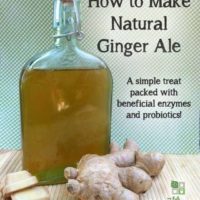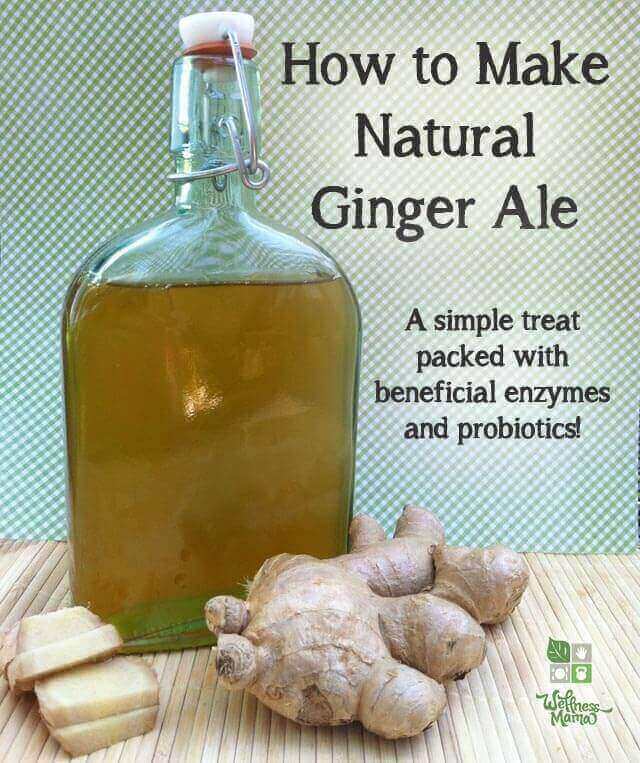It turns out that soda hasn’t always been the high fructose corn syrup and artificial flavor concoction in an aluminum can that we know today.
For hundreds of years (and probably much longer) cultures around the world have made various forms of naturally fermented “sodas” from sweetened herbal teas or fruit juice mixes. These natural fermented drinks contained beneficial enzymes and probiotics to boost health and were a far cry from the unhealthy versions we have today.
This version uses a fermented ginger culture to create a naturally fizzy soda! Ginger is a delicious herb that has been used in many cultures for its health-boosting properties. From my herb profile of ginger:
Ginger has been used in Chinese Medicine for thousands of years and is said to help:
- Soothe digestive disturbances
- Alleviate nausea (great in early pregnancy)
- Reduce fever
- Calm coughing and respiratory troubles
- Stimulate the circulatory system
- Help relieve muscle aches and pain
- Can help get rid of dandruff
- Emerging evidence shows it helps lower cholesterol
- Japanese research has found ginger is effective in lowering blood pressure and cancer risk
This natural recipe for ginger ale uses fresh ginger and a cultured ginger mixture (called a ginger bug) to create a naturally fermented and naturally fizzy ginger ale. Though this mixture can contain a small amount of alcohol if left to ferment at room temperature for weeks, we use the short brew method to create a fizzy soda without the alcohol.
Delicious Ginger Ale
Homemade ginger ale is soothing for digestive disturbances and contains probiotics and enzymes. As with any fermented product, I’d suggest starting with a small amount (4 ounce or so) and working up, as all the probiotics and enzymes can cause an upset stomach in those who aren’t used to consuming fermented products. I found small amounts of this mixture helpful in early pregnancy and any time one of us has an upset stomach, to ward off nausea. It also just tastes great!
This recipe makes 2 quarts of natural ginger ale, though the recipe can be adjusted up or down by using a ratio of ¼ cup sugar and ¼ cup ginger bug starter per 1 quart of water.

Homemade Ginger Ale Recipe
Servings
Ingredients
- 8 cups filtered water
- 1-2 inch piece of fresh ginger root minced
- ½ cup organic sugar or rapadura sugar. If using plain sugar add 1 TBSP molasses for flavor and minerals
- ½ tsp sea salt or Himalayan salt
- ½ cup fresh lemon or lime juice
- ½ cup homemade ginger bug or ¼ cup whey for a faster recipe though the flavor won’t be quite as good. Here is a tutorial for how to make whey
Instructions
- Make a “wort” for your ginger ale by placing 3 cups of the water, minced ginger root, sugar, molasses if needed, and salt in a saucepan and bringing to a boil.
- Simmer the mixture for about five minutes until sugar is dissolved and mixture starts to smell like ginger.
- Remove from heat and add additional water. This should cool it but if not, allow it to cool to room temperature before moving to the next step.
- Add fresh lemon or lime juice and ginger bug or whey.
- Transfer to a 2 quart glass mason jar with an air-tight lid. Stir well and put lid on.
- Leave on the counter for 2-3 days until carbonated. Watch this step carefully. Using whey will cause it to ferment more quickly. It should be bubble and should “hiss” like a soda when the lid is removed. This is very temperature dependent and the mixture may need to be burped or stirred during this fermentation time on the counter.
- Transfer to refrigerator where it will last indefinitely.
- Strain before drinking.
- Enjoy!
Nutrition
Notes
Have you ever made a naturally fermented drink like ginger ale, kombucha, or water kefir? What is your favorite? Share below!


Leave a Reply